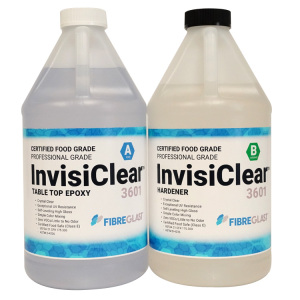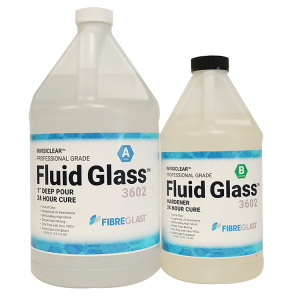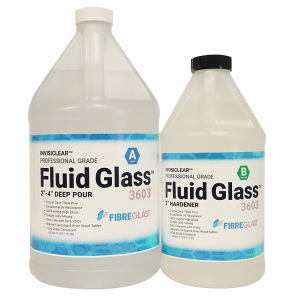Fibre Glast offers a complete line of epoxies with a wide range of pot life options. Our product line includes Epoxy Resin Systems for any application--from making quick, 10-minute repairs (System 1000) to more advanced, high-temperature vacuum infusion projects (System 4600).
Epoxy resins are considered the most advanced on the market. They often require more accuracy in measurement and handling and are generally more expensive. However, the increase in mechanical properties is worth the investment for any application where strength-to-weight is critical. Epoxy components are also more sensitive to UV degradation and will yellow when left unprotected. Fibre Glast Developments offers both a clear coating- 1045 Duratec Sunshield Clear Topcoat, and an opaque coating- Chromaglast Premium Single Stage Paint, to protect your epoxy components.
To learn more about specific product and pricing, click on an image below.
-
Our #1098 Epoxy Surface Coat is an off-white paste designed to form a tough, durable surface on patterns, fixtures,...
-
Our #1099 High Viscosity Epoxy Surface Coat is a white, thickened epoxy material used to create the durable surface...
-
Our #1101 Epoxy Paste Bonding Adhesive is a high strength structural adhesive used to bond and assemble...
-
#4118 Marine Epoxy Fairing Compound is a smooth, creamy paste system for fairing surface imperfections on...
-
Our InvisiClear Table top Epoxy is a PREMIUM epoxy coating system that uses superior ingredients for an incredibly...
-
Fluid Glass is a PREMIUM deep pour epoxy system that uses high grade ingredients for an incredible clarity, low...
-
This Fluid Glass Deep Pour Epoxy is specifically designed for applications between 2"-4". It cures rock hard and...
Fibre Glast offers a complete line of First Quality Epoxies.
Each product selected should consider the factors of fabrication, including pot life, as well as the end-use properties for your part, such as service temperature:
- System 1000 -- General purpose resin for making quick repairs and parts; available with 10- and 25-minute pot life options
- System 2000 -- For maximizing the strength of your reinforcement, such as carbon fiber; available with 20-, 60- and 120-minute pot life options
- System 3000 -- The right choice for intermediate service applications; available with a 120-minute pot life option
- 338 High Temp Tooling Epoxy -- For demanding, high-temperature service applications; pot life between 2 and 3 hours
- Marine/Epoxy Fairing Compound -- Designed for filling and fairing surface imperfections on a variety of materials, including composites, wood, plastics, and more
- Epoxy Surface Coats and Filler -- For making tough, durable surface coats with improved cosmetic properties
- Mixing Ratio: Epoxy resins require precise mixing of resin and hardener in the correct ratio to achieve proper curing. The correct mixing ratio ensures the resin and hardener react fully to create a strong and durable composite.
- Mixing Process: To achieve a thorough and homogenous mixture, the epoxy resin and hardener should be mixed together using a clean container and mixing utensils. It is important to scrape the sides and bottom of the container to ensure all components are incorporated. Mixing can be done by hand or using mechanical mixing equipment, depending on the volume and specific requirements of the application.
- Pot Life: Epoxy resins have a limited working time, known as the pot life, which refers to the time from mixing until the epoxy begins to cure and harden. For many of our epoxies, Fibre Glast offers a choice of hardeners that offer shorter or longer pot life depending on your needs. The pot life can vary depending on the specific epoxy system and environmental conditions. It is crucial to work within the pot life and avoid mixing more epoxy than can be applied or used within the specified time.
- Application Techniques: Epoxy resins can be applied using various techniques, including hand layup, wet layup, infusion, or casting. The specific application method depends on the desired outcome and the nature of the project. Follow the manufacturer's instructions and recommended techniques for the best results.
- Curing: Epoxy resins are cured through a chemical reaction between the resin and hardener. The curing time and conditions depend on the specific epoxy system. Curing typically occurs at room temperature or can be accelerated by applying heat.
- Safety Precautions: It is important to follow proper safety precautions when working with epoxy resins and hardeners. This includes wearing appropriate personal protective equipment (such as gloves, goggles, and a respirator), working in a well-ventilated area, and handling the materials according to the guidelines.
It is crucial to follow the instructions, including mixing ratios, handling, and curing guidelines specific to the epoxy resin and hardener you are using. This ensures proper curing, optimal performance, and safety during the composite fabrication process.
Want to learn more about Epoxy Resins? Fibre Glast has a free Learning Center with helpful white papers like: About Resins, Mold Construction, Molding Fiberglass, and Fundamentals of Fiberglass. You can also contrast Epoxy Resin with Polyester Resin and Vinyl Ester Resin in the Fibre Glast blog article, Choosing the Right Resin.
You can place your order right her on our website or, if you have any questions, call 1.800.838.8984 | 8 a.m. - 5 p.m. EST Mon-Fri.







